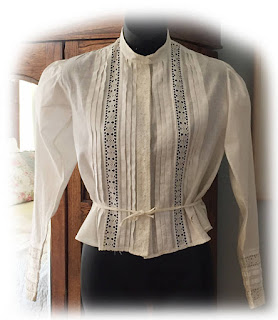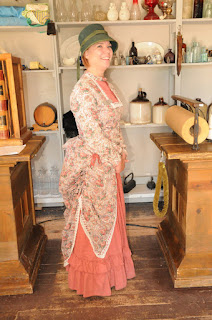One of the many attractions at Fort Bridger is its museum. As you might expect, the museum has exhibits from the various eras in the fort's history and that of the surrounding area.
This one, which shows the most elaborate marriage certificate I've ever seen, is part of a room depicting life in the late nineteenth century.
Is your wedding certificate that fancy? Mine certainly is not.
Wednesday, January 30, 2019
Friday, January 25, 2019
Meet the People of Cimarron Creek
While we're waiting for A Tender Hope to be released, I thought you might enjoy connecting (or reconnecting) with some of the people who make Cimarron Creek their home. (Many thanks to Kathy F, who reminded me that not everyone has seen my posts on other blogs and that it would be a good idea to compile a list of the most interesting ones.)
We'll start at the beginning, with A Stolen Heart.
You probably remember that the hero is Travis Whitfield, the town's sheriff, but you might not be aware of the reasons why he agreed to take that position. After all, he was already busy as the town's only attorney, and although Whitfields were raised to serve the town, surely that was enough.
But it wasn't, as I discuss on Chirp and Chatter.
Then there's Aunt Bertha, the town's matriarch and one of my favorite secondary characters. She's a feisty woman, as you'll see from this conversation on Welcome to Jenn's World.
If you've read A Borrowed Dream, you know that Catherine Whitfield's life hasn't been an easy one and that her path toward happily-ever-after takes more turns than she'd ever expected. Here's a bit of her story told in her own words on Stitches Thru Time.
We wouldn't want to neglect Austin Goddard, would we? After all, he's the hero, and he deserves his own interview. You'll find that on Novel PASTimes.
And, for a different look at both Catherine and Austin, click over to Relz Reviews for a character spotlight.
Tired of reading? I hope not, because I have one more post to share with yoiu, this one about the influence that families have on both Catherine and Austin. You'll find this one on Takeover Tuesday
I hope you enjoyed these interviews and that you're almost as excited about the upcoming release of A Tender Hope as I am.
We'll start at the beginning, with A Stolen Heart.
But it wasn't, as I discuss on Chirp and Chatter.
Then there's Aunt Bertha, the town's matriarch and one of my favorite secondary characters. She's a feisty woman, as you'll see from this conversation on Welcome to Jenn's World.
If you've read A Borrowed Dream, you know that Catherine Whitfield's life hasn't been an easy one and that her path toward happily-ever-after takes more turns than she'd ever expected. Here's a bit of her story told in her own words on Stitches Thru Time.
We wouldn't want to neglect Austin Goddard, would we? After all, he's the hero, and he deserves his own interview. You'll find that on Novel PASTimes.
And, for a different look at both Catherine and Austin, click over to Relz Reviews for a character spotlight.
Tired of reading? I hope not, because I have one more post to share with yoiu, this one about the influence that families have on both Catherine and Austin. You'll find this one on Takeover Tuesday
I hope you enjoyed these interviews and that you're almost as excited about the upcoming release of A Tender Hope as I am.
Wednesday, January 23, 2019
Wednesday in Wyoming - January 23, 2019
Remember the garage camp cabins I featured last week? Here's what the interior of one looked like. As you can see, it has some of the amenities we'd expect - a stove for heat, an electric bulb for light, a table and chairs for eating, and beds for sleeping.
What's missing? Indoor plumbing. There was a water pump not too far away, and what some called "the necessary" was located behind the cabins. The necessary, I'm sure you can guess, was an outhouse. This was, after all, camping.
What's missing? Indoor plumbing. There was a water pump not too far away, and what some called "the necessary" was located behind the cabins. The necessary, I'm sure you can guess, was an outhouse. This was, after all, camping.
Wednesday, January 16, 2019
Wednesday in Wyoming - January 16, 2019
I suspect that when most people think about Fort Bridger, they envision the nineteenth century trading post and then the army fort. How many know that it was a stop along the Lincoln Highway in the twentieth century?
When automobile travel became popular and the Lincoln Highway (now US route 30) was completed, tourists wanted a place to stay. Just as importantly, they wanted a place for their cars. Enter the "garage camp cabins."
The dark spots you see next to each of the orange cabins are garages. I imagine that, given the number of hail storms and violent thunderstorms we experience during the summer, those garages were very popular.
What did the interior of the cabins look like? Come back next week, and we'll explore them.
When automobile travel became popular and the Lincoln Highway (now US route 30) was completed, tourists wanted a place to stay. Just as importantly, they wanted a place for their cars. Enter the "garage camp cabins."
The dark spots you see next to each of the orange cabins are garages. I imagine that, given the number of hail storms and violent thunderstorms we experience during the summer, those garages were very popular.
What did the interior of the cabins look like? Come back next week, and we'll explore them.
Wednesday, January 9, 2019
Wednesday in Wyoming - January 9, 2019
What is this? As someone who did not grow up on a farm, if I hadn't seen the sign, I wouldn't have known that it was a hay baler.
I have to admit that I never thought much about how hay was baled, but seeing this tool in one of the barns at Fort Bridger made me wonder (1) how much work was involved in putting the hay into the baler and (2) what happened to the bale once it was formed. I found some of the answers here.
One thing I can tell you: I'm glad I wasn't the person harvesting and then baling hay. Sitting in front of a computer screen is much easier!
I have to admit that I never thought much about how hay was baled, but seeing this tool in one of the barns at Fort Bridger made me wonder (1) how much work was involved in putting the hay into the baler and (2) what happened to the bale once it was formed. I found some of the answers here.
One thing I can tell you: I'm glad I wasn't the person harvesting and then baling hay. Sitting in front of a computer screen is much easier!
Saturday, January 5, 2019
Behind the Cover for A Tender Hope
So many of you have told me how much you enjoy learning about the process involved in developing the wonderful covers that Revell has given me for each of my books, that -- as I promised last year -- I'm continuing to blog about them.
As is always the case, many people are involved in turning a concept into the final product, but the biggest responsibilities fall on the Art Director, Cheryl VanAndel, and the graphic designer, Dan Thornberg of Design Source Creative Services.
This time, the process included a step that I hadn't seen before, namely the creation of a cover sketch.
As you can see, it resembles the finished cover, but the model and her costume are very different. Why create a sketch at all? The reason, Cheryl explained, is to allow Revell to select the model's pose and placement prior to the photo shoot, thus streamlining the process.
One of the most important elements in my covers is the model. After all, she represents my heroine. Thea Mills is 27 years old, shorter than average, and has blonde hair, brown eyes, and a medium build. She's deeply compassionate but also fearful of having her secret revealed.
Knowing that, Revell chose Emily.
Even though you're seeing her in modern dress here, isn't it amazing how well she captures Thea's personality?
Next comes costume selection, which I freely admit is one of my favorite parts of the process, since I'm part of it.
Cheryl gave me a choice of more than half a dozen different blouses including the following:
None of those truly appealed to me, but when I saw the next one, I knew it would be perfect. In addition to its antique look, I loved the fact that it was a complete outfit and that we wouldn't have to find a coordinating skirt.
At this point, everything was ready for the photo shoot.
While the cover sketch identified one possible pose, Dan photographed Emily in several different ones.
Do you like this one?
Cheryl told me it was a top contender for the cover, but the committee preferred the next one.
I agree with them that the second pose is better for the book, in part because it emphasizes Thea's medical bag and gives a hint to her career as a midwife.
If you compare this to the final cover, you'll see that the pose is the same, but there's a big difference. Did you find it? Yes, Emily's expression is different.
Thanks to the marvels of Photoshop, Dan was able to use the head from the following picture with the body from the previous one.
The photo shoot was complete.
The model is one of the most important elements of the cover, but she's not the only one. The background is also key to setting the scene for the book and giving readers a hint about the story itself.
As is often the case, Dan used stock art for the background, starting with Thea's home in Cimarron Creek.
Don't you wish you lived in a house like this? It's beautiful, but there are a few problems, including the streetlights. Those had to be removed. And then there was the water. While it's lovely and you might believe it was Cimarron Creek itself, the creek doesn't flow through that part of the town.
What to do? Dan used flowers that might have been growing in the Hill Country to block the water.
And so we have the final cover, the one I showed you at the beginning of this post.
But the front cover is only part of the whole book. The back cover is almost as important, because that's where readers learn about the story. And the spine is critical for bookstores, since few of their books are shelved face-out.
As you might expect, given the attention that Cheryl and Dan put into the front cover, a lot of work was involved in the back cover too. Writing back cover copy is an art in itself. Fortunately, Revell has extremely talented writers who specialize in condensing a 95,000 word story into a few words. And the addition of a western picture as a cameo adds to the appeal ... at least it does for me.
I was thrilled with the cover and hope it piques your interest and makes you want to read the book.
If you'd like more information about A Tender Hope, you'll find it and buying links on my web page.
And, of course, I hope you enjoyed learning more about the cover art process. It never fails to intrigue me.
As is always the case, many people are involved in turning a concept into the final product, but the biggest responsibilities fall on the Art Director, Cheryl VanAndel, and the graphic designer, Dan Thornberg of Design Source Creative Services.
This time, the process included a step that I hadn't seen before, namely the creation of a cover sketch.
As you can see, it resembles the finished cover, but the model and her costume are very different. Why create a sketch at all? The reason, Cheryl explained, is to allow Revell to select the model's pose and placement prior to the photo shoot, thus streamlining the process.
One of the most important elements in my covers is the model. After all, she represents my heroine. Thea Mills is 27 years old, shorter than average, and has blonde hair, brown eyes, and a medium build. She's deeply compassionate but also fearful of having her secret revealed.
Knowing that, Revell chose Emily.
Even though you're seeing her in modern dress here, isn't it amazing how well she captures Thea's personality?
Next comes costume selection, which I freely admit is one of my favorite parts of the process, since I'm part of it.
Cheryl gave me a choice of more than half a dozen different blouses including the following:
None of those truly appealed to me, but when I saw the next one, I knew it would be perfect. In addition to its antique look, I loved the fact that it was a complete outfit and that we wouldn't have to find a coordinating skirt.
At this point, everything was ready for the photo shoot.
While the cover sketch identified one possible pose, Dan photographed Emily in several different ones.
Do you like this one?
Cheryl told me it was a top contender for the cover, but the committee preferred the next one.
I agree with them that the second pose is better for the book, in part because it emphasizes Thea's medical bag and gives a hint to her career as a midwife.
If you compare this to the final cover, you'll see that the pose is the same, but there's a big difference. Did you find it? Yes, Emily's expression is different.
Thanks to the marvels of Photoshop, Dan was able to use the head from the following picture with the body from the previous one.
The photo shoot was complete.
The model is one of the most important elements of the cover, but she's not the only one. The background is also key to setting the scene for the book and giving readers a hint about the story itself.
As is often the case, Dan used stock art for the background, starting with Thea's home in Cimarron Creek.
Don't you wish you lived in a house like this? It's beautiful, but there are a few problems, including the streetlights. Those had to be removed. And then there was the water. While it's lovely and you might believe it was Cimarron Creek itself, the creek doesn't flow through that part of the town.
What to do? Dan used flowers that might have been growing in the Hill Country to block the water.
And so we have the final cover, the one I showed you at the beginning of this post.
But the front cover is only part of the whole book. The back cover is almost as important, because that's where readers learn about the story. And the spine is critical for bookstores, since few of their books are shelved face-out.
As you might expect, given the attention that Cheryl and Dan put into the front cover, a lot of work was involved in the back cover too. Writing back cover copy is an art in itself. Fortunately, Revell has extremely talented writers who specialize in condensing a 95,000 word story into a few words. And the addition of a western picture as a cameo adds to the appeal ... at least it does for me.
I was thrilled with the cover and hope it piques your interest and makes you want to read the book.
If you'd like more information about A Tender Hope, you'll find it and buying links on my web page.
And, of course, I hope you enjoyed learning more about the cover art process. It never fails to intrigue me.
Wednesday, January 2, 2019
Wednesday in Wyoming - January 2, 2019
Happy New Year and welcome back to Fort Bridger! I found so many interesting things that I wanted to share with you that it's going to take several months to finish.
The first stop on any visitor's tour ought to be the sutler's store. It was here that families who were living on the post bought everything from foodstuffs to saddles to hats to bathtubs. Yes, bathtubs.
Currently, in addition to showcasing the goods that were once sold in the store, it serves as the visitor's center. It's here that you have the opportunity to have your questions answered, and - if you arrive at the right time - to tour the fort with an authentically costumed guide.
As attractive as her costume is, I can tell you that the bustle made sitting a bit of a challenge. I also wouldn't want to be wearing multiple layers of long skirts and long sleeves in a hot Wyoming summer. There are definite advantages to living in the 21st century.
The first stop on any visitor's tour ought to be the sutler's store. It was here that families who were living on the post bought everything from foodstuffs to saddles to hats to bathtubs. Yes, bathtubs.
Currently, in addition to showcasing the goods that were once sold in the store, it serves as the visitor's center. It's here that you have the opportunity to have your questions answered, and - if you arrive at the right time - to tour the fort with an authentically costumed guide.
As attractive as her costume is, I can tell you that the bustle made sitting a bit of a challenge. I also wouldn't want to be wearing multiple layers of long skirts and long sleeves in a hot Wyoming summer. There are definite advantages to living in the 21st century.





















